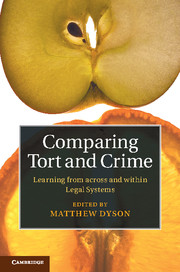
-
Select format
-
- Publisher:
- Cambridge University Press
- Publication date:
- August 2015
- July 2015
- ISBN:
- 9781139946285
- 9781107080485
- Dimensions:
- (228 x 152 mm)
- Weight & Pages:
- 0.93kg, 558 Pages
- Dimensions:
- Weight & Pages:
- Subjects:
- Tort Law, Law, Private Law
You may already have access via personal or institutional login- Subjects:
- Tort Law, Law, Private Law
Book description
The fields of tort and crime have much in common in practice, particularly in how they both try to respond to wrongs and regulate future behaviour. Despite this commonality in fact, fascinating difficulties have hitherto not been resolved about how legal systems co-ordinate (or leave wild) the border between tort and crime. What is the purpose of tort law and criminal law, and how do you tell the difference between them? Do criminal lawyers and civil lawyers reason and argue in the same way? Are the rules on capacity, consent, fault, causation, secondary liability or defences the same in tort as in crime? How do the rules of procedure operate for each area? Are there points of overlap? When, how and why do tort and crime interact? This volume systematically answers these and other questions for eight legal systems: England, France, Germany, Sweden, Spain, Scotland, the Netherlands and Australia.
Reviews
'Dyson provides a broad and measured study with a wealth of insights at all levels of abstraction. He might be thought in some respects to have led his reader through an aporetic dialogue to an unsettling appreciation of our extensive ignorance; nothing becomes as clear as the need to know more. Throughout the text, however, Dyson specifically highlights a myriad of areas for further investigation and casts clear light on where he sees that the analysis should lead next.'
Andrew J. Bell Source: Rabels Zeitschrift für ausländisches und internationales Privatrecht
Contents
Metrics
Altmetric attention score
Full text views
Full text views help Loading metrics...
Loading metrics...
* Views captured on Cambridge Core between #date#. This data will be updated every 24 hours.
Usage data cannot currently be displayed.
Accessibility standard: Unknown
Why this information is here
This section outlines the accessibility features of this content - including support for screen readers, full keyboard navigation and high-contrast display options. This may not be relevant for you.
Accessibility Information
Accessibility compliance for the PDF of this book is currently unknown and may be updated in the future.


